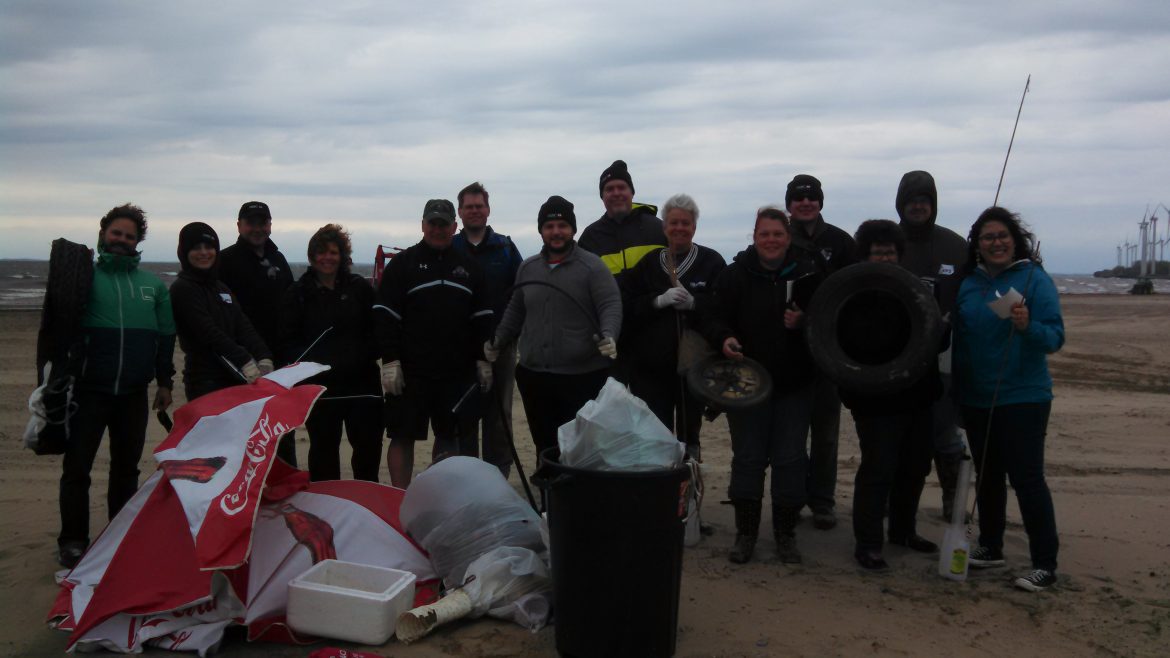
Students from Journey’s End Refugee Services at a cleanup at Beaver Island State Park in Grand Island, NY. Image: Alliance for the Great Lakes
By Kate Habrel
What do cigarette butts, takeout containers, straws and water bottles have in common? They’re some of the most common litter found on Lake Michigan and Lake Erie beaches, according to a recent study published in Science of the Total Environment.
Most pieces of “tiny trash” – pieces 2.5 centimeters long or smaller – are also mostly plastic. They include pieces of bigger objects, fibers from sweaters and beads from facewash – all examples of microplastics.
Concentrations of larger litter vary by season. There’s more trash found near Chicago in the fall, but more on the beaches in Buffalo and nearby parts of New York in spring, according to the study.

College students from SUNY Fredonia at a cleanup in Dunkirk, NY. Image: Christina Jarvis
“My personal theory is that, maybe there’s more trash on beaches in the spring in Buffalo because when the snow finally melts and winter’s over, we’re very excited to get outside,” said Nate Drag, water project manager at the Alliance for the Great Lakes, who assisted with the study.
However, tiny trash amounts are stable regardless of season. They may be coming directly from people living on the water. Currents in the Great Lakes might pick up the tiny trash and carry it from lake to lake, according to Drag.
“One other thing that backs that idea up is there are higher concentrations of tiny trash on beaches in New York compared to beaches in Illinois,” Drag said. “Technically we’re downstream from the other three Great Lakes, so we have higher concentrations of tiny trash on the beaches.”
The highest concentrations of larger trash were also found on urban beaches.
The study came together when Timothy Hoellein, associate professor in the Department of Biology at Loyola University, teamed up with the Alliance for the Great Lakes.
Hoellein signed his ecology class up for an extra credit session of cleaning up trash. While there, he learned the alliance had beach cleanup data spanning over a decade. He used information collected from a four-year project in which employees from HSBC Bank collected data.

A group of HSBC volunteers after an Adopt-a-Beach cleanup at Woodlawn Beach, NY. Image: Nate Drag/Alliance for the Great Lakes
The effect of plastic tiny trash on wildlife is not yet known. However, an ongoing study suggests it is a larger problem than what reaches the beach.
“We’re looking at these very small plastic particles at the river outlets to Lake Michigan,” Hoellein said. “We’re measuring small bits of plastic in the water and sediment and in minnows. We must have dissected a hundred fish, and we found a piece of plastic in every one of them.”
But there is good news for Great Lakes beaches. Unlike ocean beaches, which can gather trash from across the world, litter on Great Lakes beaches comes from local sources.
While that doesn’t sound like a good thing, it does mean through proper management, beaches can continue to keep clean.
“I think there’s local and state governments that can really do something and make a real difference, and that’s a positive thing to learn,” Hoellein said.